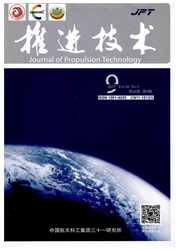

 中文摘要:
中文摘要:
在来流总温1486K,总压1.6MPa,马赫数2.52的条件下,采用两级串联凹腔构型燃烧室,开展了电火花塞直接点燃航空煤油的试验研究。利用高速摄影相机进行观测,对比了不同煤油喷注方案和点火位置对火核生成和火焰传播的影响。通过上游凹腔前壁面水平喷注煤油、下游凹腔点火的方案可靠性高,在煤油与空气混合气的当量比为0.04~0.063均可实现煤油成功点火和稳定燃烧;串联凹腔构型可以提高点火性能的主要原因有两方面:一是下游凹腔有稳定火焰作用,火焰在边界层内逆流传播实现对上游凹腔的能量反馈;二是煤油蒸发、混合距离长,通过近壁区进入下游凹腔,形成了更为适宜的点火环境。
 英文摘要:
英文摘要:
Experimental investigations on spark ignition of liquid kerosene in a scramjet combustor with two-staged cavities were conducted at the inflow conditions of Ma=2.52,T0=1486K,p0=1.6MPa. High speed photography was used to recorder the flame propagation processes,to compare the effects of kerosene injection schemes and ignition positions on the formation of flame core and flame propagation. When kerosene was injected from the leading edge of the upstream cavity(overall equivalent ratio=0.04~0.063) and ignited by the spark in the downstream cavity,it will lead to a reliable ignition with large margin of flame stability. The combustor configuration with two-stage cavities can improve the ignition ability. Firstly,the downstream cavity stabilizes the flame,and then the flame propagates upstream through boundary layer and provides energy for the ignition in upstream cavity. Secondly,the kerosene injected at upstream cavity passes a long distance in near wall area for evaporation and mixing with the fresh air before it is entrained into the downstream cavity,and produce a better ignition environment in downstream cavity.
 同期刊论文项目
同期刊论文项目
 同项目期刊论文
同项目期刊论文
 Catalytic Cracking of Supercritical n-Dodecane over Wall-Coated HZSM-5 Zeolites with Micro- and Nano
Catalytic Cracking of Supercritical n-Dodecane over Wall-Coated HZSM-5 Zeolites with Micro- and Nano Influences of the turbulence model and the slot width on the transverse slot injection flow field in
Influences of the turbulence model and the slot width on the transverse slot injection flow field in Preparation and performance of hierarchical HZSM-5 coatings on stainless steeled microchannels for c
Preparation and performance of hierarchical HZSM-5 coatings on stainless steeled microchannels for c 期刊信息
期刊信息
